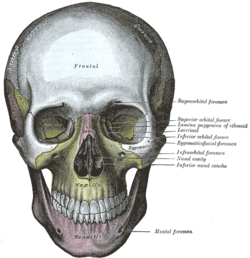Infraorbital foramen
| Infraorbital foramen | |
|---|---|
 The skull from the front. (Infraorbital foramen labeled at center right, under the eye.) | |
 Articulation of nasal and lacrimal bones with maxilla. (Infraorbital foramen labeled at left.) | |
| Identifiers | |
| TA98 | A02.1.12.008 |
| TA2 | 763 |
| FMA | 57718 |
| Anatomical terms of bone | |
In human anatomy, the infraorbital foramen (IOF) is an opening in the skull located below the infraorbital margin (IOM) of the orbit (eye socket). It allows passage for the infraorbital artery, vein, and nerve. The IOF-IOM distance varies between 6.10 to 10.9 mm (0.240 to 0.429 in).[1] Forming the exterior end of the infraorbital canal, the infraorbital foramen communicates with the infraorbital groove, the canal's opening on the interior side.
The ramifications of the three principal branches of the trigeminal nerve — at the supraorbital, infraorbital, and mental foramina — are distributed on a vertical line (in anterior view) passing through the middle of the pupil. The infraorbital foramina is used as a pressure point to test the sensitivity of the infraorbital nerve.[2]
See also
Additional images
-
A Grizzly bear's skull with the left infraorbital foramina clearly visible
-
1 Foramen ethmoidale, 2 Canalis opticus, 3 Fissura orbitalis superior, 4 Fossa sacci lacrimalis, 5 Sulcus infraorbitalis, 6 Fissura orbitalis inferior, 7 Foramen infraorbitale
References
- ^ Macedo, VC; Cabrini, RR; Faig-Leite, H (2009). "Infraorbital foramen location in dry human skulls" (PDF). Braz. J. Morphol. Sci. 26 (1): 35–38.
- ^ Platzer, Werner (2004). Color Atlas of Human Anatomy, Vol. 1: Locomotor System (5th ed.). Thieme. p. 336. ISBN 3-13-533305-1.
External links
- cranialnerves at The Anatomy Lesson by Wesley Norman (Georgetown University) (V)
- Anatomy photo:29:os-0506 at the SUNY Downstate Medical Center (closeup)
- Anatomy figure: 22:02-08 at Human Anatomy Online, SUNY Downstate Medical Center (distance)
- Upstate.edu
- Template:RocheLexicon


